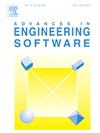Research on the optimization of robot operation path in the automated production of precast concrete floor slab
IF 5.7
2区 工程技术
Q2 COMPUTER SCIENCE, INTERDISCIPLINARY APPLICATIONS
引用次数: 0
Abstract
The application of intelligent construction robots has enhanced the automation level of precast concrete (PC) floor slab production. The method of programming the working paths of robots using a manual teaching pendant often results in numerous redundant movements. To enhance the efficiency of the robots, an improved electric eel foraging optimization (IEEFO) algorithm was utilized to optimize the working paths of intelligent construction robots. The optimized paths were tested in the automated production of PC floor slab using a dual-arm robotic system on a comprehensive training platform for intelligent construction robots. The experiment results indicate that, compared to the robot working paths obtained through manual teaching pendant programming, the path optimization algorithm improved the number of steps by 66.7 %, production efficiency by 14.4 %, and production accuracy 7 % for PC floor slab production. Additionally, the algorithm facilitated collaborative multi-robot operations, thereby reducing the safety risk of human-robot collisions.
预制混凝土楼板自动化生产中机器人作业路径优化研究
智能施工机器人的应用提高了预制混凝土楼板生产的自动化水平。使用人工教学挂件对机器人工作路径进行编程的方法往往会导致大量的冗余动作。为了提高智能施工机器人的工作效率,采用改进的电鳗觅食优化算法对智能施工机器人的工作路径进行优化。在智能施工机器人综合训练平台上,利用双臂机器人系统对优化路径进行了PC楼板自动化生产试验。实验结果表明,与手工教学挂件编程得到的机器人工作路径相比,该路径优化算法在PC楼板生产中,生产步数提高了66.7%,生产效率提高了14.4%,生产精度提高了7%。此外,该算法促进了多机器人协作操作,从而降低了人机碰撞的安全风险。
本文章由计算机程序翻译,如有差异,请以英文原文为准。
求助全文
约1分钟内获得全文
求助全文
来源期刊

Advances in Engineering Software
工程技术-计算机:跨学科应用
CiteScore
7.70
自引率
4.20%
发文量
169
审稿时长
37 days
期刊介绍:
The objective of this journal is to communicate recent and projected advances in computer-based engineering techniques. The fields covered include mechanical, aerospace, civil and environmental engineering, with an emphasis on research and development leading to practical problem-solving.
The scope of the journal includes:
• Innovative computational strategies and numerical algorithms for large-scale engineering problems
• Analysis and simulation techniques and systems
• Model and mesh generation
• Control of the accuracy, stability and efficiency of computational process
• Exploitation of new computing environments (eg distributed hetergeneous and collaborative computing)
• Advanced visualization techniques, virtual environments and prototyping
• Applications of AI, knowledge-based systems, computational intelligence, including fuzzy logic, neural networks and evolutionary computations
• Application of object-oriented technology to engineering problems
• Intelligent human computer interfaces
• Design automation, multidisciplinary design and optimization
• CAD, CAE and integrated process and product development systems
• Quality and reliability.
 求助内容:
求助内容: 应助结果提醒方式:
应助结果提醒方式:


